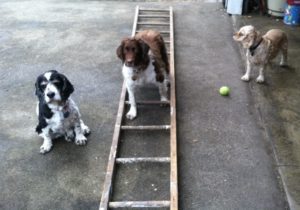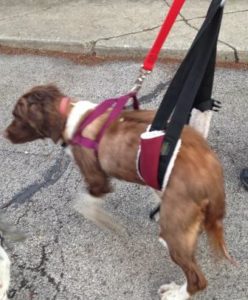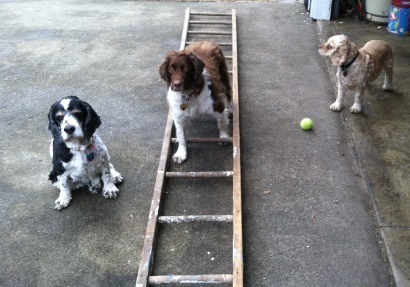Symptoms
Symptoms of Cassie’s brain tumor came on fast. Although in hindsight, maybe they started many months before her diagnosis. A few months past her eleventh birthday, she started tripping several times each day. She usually caught herself, but sometimes would bash her chin on the ground or against a cabinet or stair.
I mentioned her loss of balance to my vet when Cassie had her bimonthly blood check for chronic lymphocytic leukemia (CLL), which she had for three years. Cassie had been fairly symptom free, except for the dull, thinning fur and leaky bladder caused by her chemotherapy drugs. The vet checked Cassie’s limbs and said that my springer spaniel is likely not picking up her paws completely due to arthritis, so she recommended I have her walk over something every day to encourage her to lift her legs higher.
I remembered a similar task for agility class close to a decade ago, when I walked Cassie over a straight wooden ladder placed on the ground. So every morning, I carried the ladder out from the garage and laid it on the driveway. Without the need for a leash, I taught her the ladder command as she walked back and forth across the rungs for its entire twelve-foot length and repeated it four times. She loved training again, something we hadn’t done in years. She’d bark her enthusiasm, no matter what the weather in early January. This little trick reduced her trips to only once every few days.

At the end of March, we traveled to southern Illinois to camp and hike at Garden of the God’s in the Shawnee National Forest, where the weather was much warmer. My husband and I also brought my two cocker spaniels, which we had inherited from my mom. Chipper, the nine-year-old cocker had to stay in the car while we hiked since he was recovering from a torn ACL. I had warned Mitch that we shouldn’t go far due to Cassie’s arthritis, but he thought he could find a short cut and we ended up hiking about an hour off trail through the hills and ravines of the state park. Cassie did fine, enjoying her freedom to explore and follow us. Little did we know that in six weeks she’d be dead.
Two weeks later, Cassie lost her balance about a half dozen times a day. The cockers had their annual vet appointment a week later, so I asked to add Cassie to the visit. I feared she’d break a leg and I knew she wouldn’t mend well. Cassie had a sore on her back that hadn’t healed in months—a small skin abscess that had the scab continually rubbed off by her diaper that she needed for her leaky bladder. Her chemotherapy drugs and the steroid prednisone caused her skin and fur to deteriorate after years of ingestion.
Diagnosis
The vet diagnosed Cassie with arthritis in opposing limbs and said this caused her imbalance. So we tried laser treatments on her back left limb. The previous summer Cassie had this treatment on her right front leg, although it didn’t seem to make any difference. But lacking any other choices, I decided to go for it. Six treatments were required about three to five days apart. By the time of her first treatment the following Tuesday, Cassie was tripping at least a dozen times a day. My husband took her in for the next treatment on Saturday since I was out of town until late Sunday night.
On Monday morning, I woke early and carried Cassie off the bed and down the stairs to the first floor, something I had been doing for the past few weeks to prevent her from falling down the stairs. At the bottom of the stairs, I set Cassie down squarely on all four legs. She wobbled and leaned into my legs. I tried to help her balance, but every time I moved, she’d start to fall. Three days prior, when I had last seen her, she had no trouble walking once I put her down.
I called up to my husband to ask what was going on. He replied that she just took a minute to adjust but then she’d be fine. Cassie wasn’t fine. I carried her outside to the grass and let her go so she could pee. She wobbled a lot but was able to squat before falling over. Something was definitely wrong. After two laser treatments, she should have walked better.
The vet saw Cassie a few hours later and told me that she had symptoms of a brain tumor. I called my husband and put him on speaker phone so he could hear her diagnosis and ask questions. The vet mentioned three possibilities:
- She didn’t recommend surgery, since often it doesn’t help and with Cassie’s poor healing ability, recovery would be very slow.
- Doubling Cassie’s dosage of the steroid prednisone since that could shrink the tumor and give her a few more months to live.
- Antibiotics could help if Cassie had an inner ear infection, which was a remote possibility.
- Schedule an appointment with a neurologist veterinarian for a second opinion.
We opted for a second opinion. My husband works in a neuroscience lab and had researched ataxia (loss of balance), which could be a side effect from Cassie’s drugs.
Care
On Wednesday, my husband and I walked Cassie into the neurologist’s office. She now needed a sling and harness to help guide her since she kept curving toward the left and falling. The neurologist had the same diagnosis and recommended increasing the dosage of prednisone.

With our assistance, Cassie could take short walks with my cockers up to the corner and back. She really wanted to walk with them, as she had for years. My husband used the sling and harness to balance her so she could do her business. We brought down extra rugs from the attic and covered the tiled kitchen floor so Cassie could grip the floor and walk a few steps before falling.
On Friday evening, I came home from work and she greeted me at the gate, walking erratically, but walking. I was ecstatic thinking she was getting better. But on Saturday morning, she couldn’t walk at all. For the first time we discussed the possibility of euthanizing her or waiting to see if the increased prednisone would have any effect.
I called the vet to cancel Cassie’s laser treatment and asked her advice. She thought Cassie’s condition shouldn’t degrade that quickly and suggested that we try motion sickness pills in case she had vestibular disease, which causes a very wobbly gait and turning in one direction.
We gave Cassie more drugs as we hoped for a miracle. Both the prednisone and the motion sickness pills could take a few days to be effective. But Cassie continued to deteriorate. She still loved to eat, especially licking our dinner pots, but seemed very frustrated at her body’s lack of coordination.
By Tuesday morning, we couldn’t get Cassie relaxed enough to eliminate. Her body kept curving into a tight “C” to the left and she could no longer stand, even with assistance. We knew it was time to put her down. She remained enthusiastic until the end, eating her favorite liver treats. She died very peacefully.
Lessons Learned
- Get a second opinion – especially when serious conditions occur.
- Involve your spouse or others in your family in the decision making and visits to the vet. This prevents you from misinterpreting the vet’s diagnosis and prognosis.
- Symptoms can sometimes arise quickly, or creep up slowly, almost undetectable since you see your dog every day. Keep a dog journal.
- Buy a harness with a short leash and a sling. You just never know when you will need it. I have used this combination many times to help my dogs walk after an injury.
- Keep the dog in a carpeted room to aid their walking and prevent slippage and injury.
- Question the vet and research your pet’s condition.
Cassie’s brain tumor was likely a secondary cancer caused by her leukemia. I didn’t know that brain tumors often form as secondary cancers. I’m not sure if I would have appreciated this knowledge ahead of time, but the shock of hearing she had a brain tumor, and her rapid deterioration may have been lessened.
Please feel free to comment, email me a story about one of your pets, or read my page on brain tumors to find out more.

